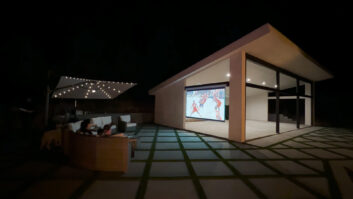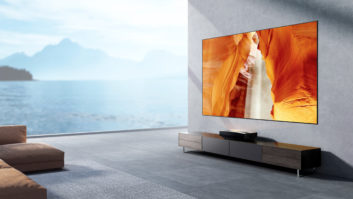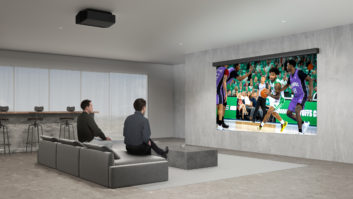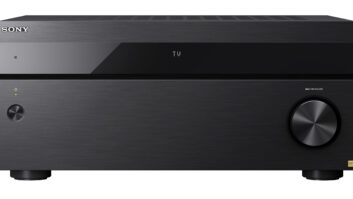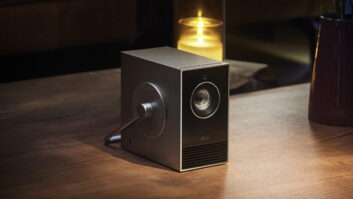Like most people who are passionate about home theater, I’m a projector guy.
Sure, massive LEDs have some real advantages over two-piece projection systems — they’re brighter, don’t need controlled lighting, have superior HDR handling, and are generally easier to install — but they just don’t deliver the same cinematic experience.
I did a major upfit of my own home theater system nearly 15 years ago that included adding a Marantz 1080p DLP projector and a motorized dual-aspect Draper screen that was 92 inches for 16×9 but that opened to 115 inches for 2.35 content. And even after all these years I’m still thrilled by the experience every time we roll that screen down and watch a movie.
Of course, projection technology has come a long way in the past 15 years, and my theater is now ready for its third projector, so I was thrilled when Sony introduced a trio of new 4K Laser projectors earlier this year. All of the new projectors offer significant performance and feature upgrades over previous models — including video processing previously only available on Sony’s flagship VPL-GTZ380 — while remaining price competitive.
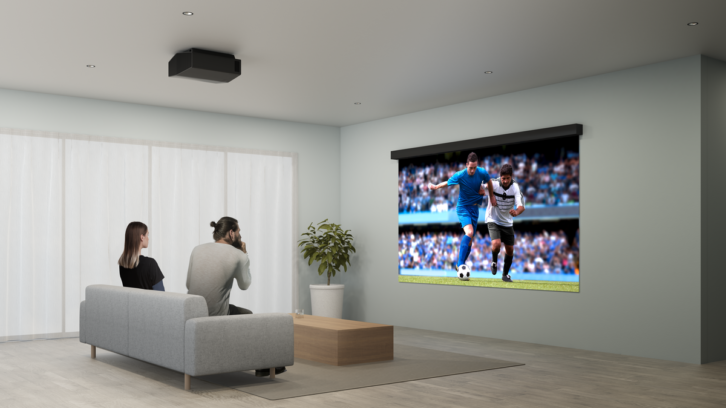
For review, Sony sent the VPL-XW5000ES, the entry model, which retails for a very attractive $6000. To understand how truly impressive and aggressive this price point is, Sony’s previous entry-level laser model — the VPL-VW915ES — offered the same 2000-lumen output, featured a less powerful video processor, and retailed for $20,000! One note: If ordering, take care not to confuse the VPL-XW5000ES with Sony’s VPL-VW5000ES, the previous flagship model that retailed for $60,000.
Upgrades and Improvements
Sony has a long history of innovation in the home projection market, dating back 50 years to 1972 when it introduced the VPP-2100, the company’s first color CRT projector. In 2003 Sony debuted the Qualia 004, the world’s first full 1920×1080 HD projector, and then, in 2011, the company released the VPL-VW1000ES, the world’s first 4K home projector.
Of course, the XW5000ES’ biggest selling point will be its Z-Phosphor laser-light engine, producing up to 2000 lumens of brightness. The key selling points of laser are a long life with virtually zero maintenance, with the new models having an estimated 20,000 hours of operation to 50 percent brightness. Beyond longevity, a laser light source offers other benefits over traditional lamp-based projectors, such as consistent brightness and color across its lifespan, less turn-on “stress” on the light engine, and the ability to instantly turn off to deliver a true black. Laser can also have quicker turn on/off times, not requiring the lengthy “cool down” period of lamp-based models. The XW5000ES was indeed quick to power down but took about 50 seconds to produce an image on the screen when coming on.
The new lineup also benefits from a host of other upgrades, significantly the use of Sony’s X1 Ultimate for Projector video processing. This utilizes four-key Sony video processing technologies, including Object-based Super Resolution that detects individual objects in the picture to apply individual processing and enhancement, Dual Database Processing that both cleans up the image by reducing noise and upscales resolution improving clarity, Digital Focus Optimizer to achieve optimal focus both optically and digitally across the entire screen, and Object-based HDR Remaster to deliver images with brighter highlights and deeper blacks that more closely match the content creators’ intent.
The new lineup also includes wide dynamic range optics that are not only smaller, but deliver higher brightness and produce more contrast and improved luminance over a wide spectrum of colors. Along with Triluminos Pro — another feature ported down from the GTZ-380 — the XW5000ES is capable of producing up to 95 percent of the DCI-P3 color gamut without needing a filter.
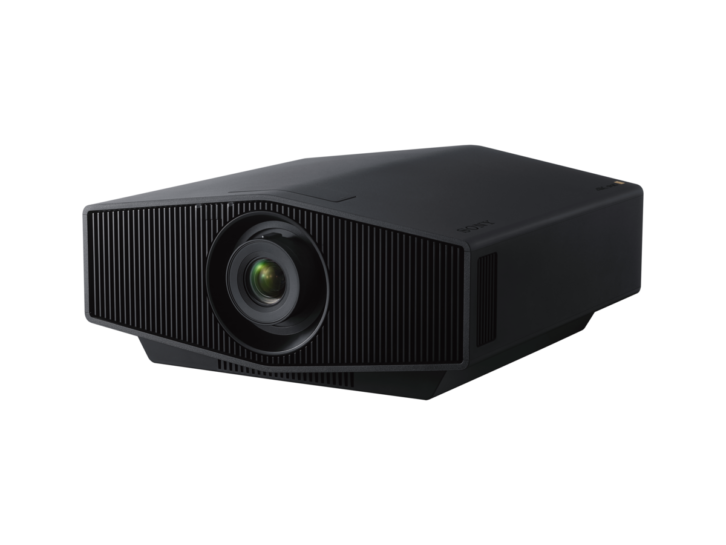
Previously, Sony’s home 4K projection models used a digital cinema aspect 4096×2160 pixel array, but this series features newly designed, smaller .61-inch SXRD panels. Besides delivering a more home-friendly 3840×2160 resolution, they also have a flatter reflective surface, a 10 percent higher light reflectance, and achieve a 50 percent higher light resistance, which produces better contrast. The projector also features a newly developed optical system with a smaller optical block, new laser diodes, and a new cooling system delivering better laser efficiency.
These size reductions, along with a new lens and a modern chassis design with angled, sleeker top and bottom panels, make the XW5000ES the most compact native 4K laser projector available. In comparison, it is about 30 percent smaller in volume and 35 percent lighter than Sony’s previous VPL-VW915ES laser projector. The end result is a projector that doesn’t look as imposing hanging from the ceiling. It is also available in either black or white.
Install
Like virtually every modern projector, the Sony offers the ability to be front-, rear-, ceiling-, or shelf-mounted. Sony doesn’t offer a ceiling mount for this, but your favorite Chief, Peerless, Strong, or other universal projector mount should work. This projector does utilize only three mounting holes (versus four), but it’s significantly lighter weight should make install a breeze.
As it was a review sample that would not be a permanent resident in my theater, I just set it on a box in my kitchen, which happens to line-up centered on my screen. Once I got it square and level to the screen, install was as simple as adjusting the lens to fit and focus on the screen.
The 5000ES’ manual lens has a throw ratio of 1.38:1 to 2.21:1. This means for a 100-inch, 16×9 image, the projector could sit anywhere from 121 to 192 inches from the screen, and for a 150-inch image, it could sit from 181 to 289 inches. This generous range should give it the ability to replace almost any existing projector at the same location.
It also offers a vertical lens shift of +/- 71 percent, and a horizontal shift of +/- 25 percent via two roller, gear wheels located on the top (bottom if ceiling mounted) front of the projector concealed behind a removable panel.
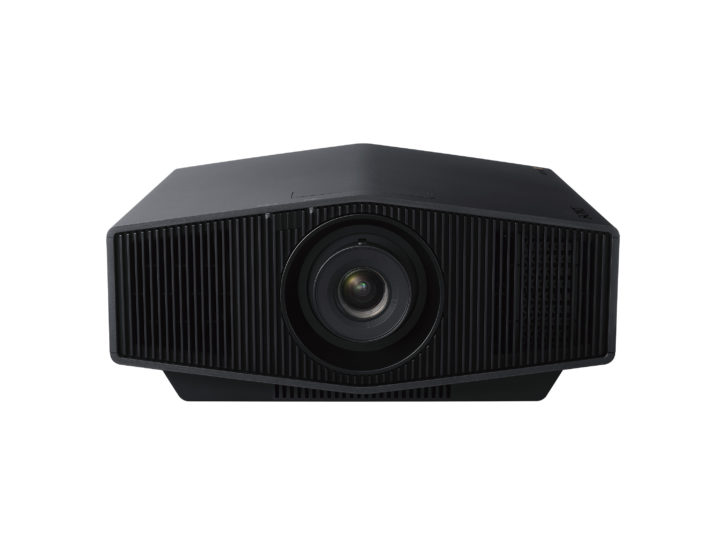
Because I have a dual-aspect screen, I used the manual lens shift, focus, and lens shift controls pretty frequently to zoom/shift/focus in/out as I changed from 16×9 to 2.35 and back. The lens zoom and focus rings move with nice precision, like an SLR camera, letting you get things dialed in really tight. The lens shift gears, however, didn’t have the same precise adjustments, making me think of the quote from The Bourne Identity where Jason Bourne said, “The tires felt a little splashy on the way over here.” The shift in both directions is just a little hitchy, with the gear frequently jumping quite a bit or settling back, making it difficult to get the edges perfectly lined up. With a little patience, you can ultimately get it where you want, and in a typical single-aspect install, this will be a set-and-forget adjustment. The projector also offers digital blanking for all four sides, which helps if you have a bit of overspray.
For those with an anamorphic lens, the Sony has stretch settings that work with both 1.24 and 1.32 lenses.
The projector includes two HDMI inputs along with connections for hardwired IR, a 12-volt trigger, DB9 RS-232, and an RJ45 for connection to a LAN, all located on the side near the back, with a detachable power connection on the opposite side. (There is also a USB connection that is used for service and firmware updates.) These connections are on angled sections near the bottom of the projector, so they don’t stick out beyond the side of the chassis and likely wouldn’t be visible when ceiling-mounted.
One note about the HDMI inputs: These are HDMI 2.0b inputs and only accept 18 Gbps signals up to 4K/60 or 2K/120, so if you are hoping to game in 4K/120, you’ll need to look elsewhere.
Another feature not to be missed is the Panel Alignment adjustment that lets you tweak the pixel position at multiple points on screen for the most accurate alignment. Similar to the old point adjustment on CRT projectors, you navigate a grid pattern on screen and align the red and blue panels for the sharpest image. This process can take a few minutes to complete, but it certainly makes tiny details and things like text sharper with less color fringing.
Sony has proven itself very friendly to the CI channel by providing loads of discrete commands and IP integration, and this continues with the new PJ lineup. There are a wide range of integration possibilities for getting the XW5000ES to work with your preferred automation system. Beyond the mini-jack IR input, it supports Control4 SDDP, Crestron Connected, Savant, and AMX DDDP. It also works with OvrC and Domotz. You have full access to all the projector’s settings and configurations over the local LAN.
A look through the IP command set for Control4 reveals discrete access to virtually every option or setting you would want, letting you give customers access — or pre-programming commands — to switch to the ideal picture mode or setting when watching different sources or resolutions.
While users will likely use it very sparingly, if at all, the included remote control has discrete access to all of the preset picture modes, as well as Motionflow, Contrast Enhancer, and Reality Creation settings. And it is backlit for easier operation in a darkened theater.
Performance
The XW5000ES arrived rather unexpectedly right before CEDIA, and after having it installed for just two weeks, Sony requested I ship it back so they could have it for the show. But even in that first brief encounter, I could tell it delivered an impressively bright and detailed image. The first thing I put up on my screen was the Kaleidescape cover art GUI, and the image had tons of detail and sharpness, with vibrant colors.
Fortunately, Sony returned the projector to me following CEDIA, giving me significantly more time to run it through its paces.
The most accurate out-of-box picture mode is Reference, which turns off much of the unit’s processing and dials back the HDR contrast enhancement tone mapping.
While Reference might be the most “accurate,” I preferred Bright Cinema, especially when it came to viewing HDR content. In this mode, the unit is a bit more aggressive on the contrast, and I felt that it restored some punch to images without blowing out colors like a “Vivid” mode. The default color temperature setting is D75, which I found a bit too cool, pushing blue. Switching to D65 helped bring skies’ colors back to a more accurate shade, especially in scenes with a lot of blue.
In Bright Cinema mode, HDR images just had more pop, making things like explosions, fires, electricity, lights, and other visual effects more vibrant and exciting.
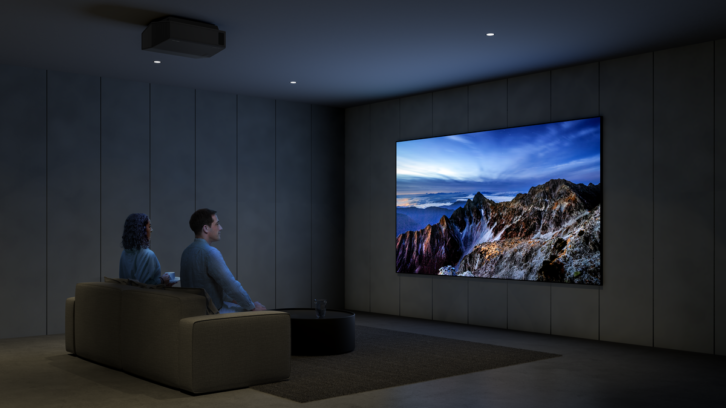
I know that for many “purists,” any kind of video processing or enhancement is anathema, but I have a more open mind to processing. Kind of like traction control on a Ferrari — is it the purist expression of what the car is capable of? Maybe not, but it might keep you from stacking a six-figure car into the wall.
I feel that not all video processing is good, but not all of it is bad either. While “max” is usually “too much of a good thing,” sometimes a small “pinch” of something can make it look better. And, ultimately, if the end user/viewers feel it looks better, that’s the correct setting. Accordingly, I spent a good bit of time going through the different Reality Creation, Motionflow, and HDR Enhancer settings to find what looked the best for me.
The two settings that seemed to have the most impact on picture performance were the Digital Focus Optimizer (DFO) and the HDR Enhancer.
DFO added some sharpness and edge enhancement to fine details, specifically very tight lines, but the effects were typically so subtle that I often had a difficult time discerning changes with moving images. (In many ways, the effect of DFO reminded me of Darbee’s video processing from back in the day.) Toggling DFO on/off during Kaleidescape’s cover screen GUI, you could see where the processing was being applied and its effects. For example, the fine lines of the Twin Towers on the cover art of The Walk were over-sharpened, making them blur together, and the small text in some covers became unreadable after the processing.
For most things, DFO wasn’t objectionable, however when watching the 4K HDR version of Vertigo, during one scene the processing amplified the grain, noise, and clouds in the image to the point where it produced a very visible pink checkerboard pattern across the blue sky. During one test pattern on the Spears & Munsil UHD HDR Benchmark 4K Blu-ray, DFO turned two thin white lines into one greenish/black line. According to Sony engineering, “We recommend to turn off ‘DFO’ for content that is graded without fine resolution and has a lot of grain noise such as content that are graded like old film.” Ultimately, I chose to turn DFO off.
While frame-by-frame HDR processing occurs at all times, the HDR Enhancer setting determines how aggressively the projector performs HDR tone mapping, essentially adjusting the tradeoff between white clipping and average picture level.
HDR Enhancer offers off/low/med/high options, letting you fine-tune to your preference. Watching still frames with a lot of bright highlights really shows the effect this has on the image, letting you pick your preferred look. The 4K HDR Kaleidescape download of Black Adam has a ton of bright, HDR effects like vibrant red-orange explosions and fireballs and glowing blue-white electricity, and the “Teth Adam Paints the Enemy Black” scene proved to be a great test for showing how HDR Enhancer works and the tradeoffs.
When set to high, bright objects were a bit blown out, and lost fine detail such as the individual branches of electricity melding together, but when turned off, the image just didn’t have enough pop. Ultimately, I settled on “low” for the best balance between loss of punch and detail, but medium might be better for a larger screen.
Sony is really known for its superior motion handling, and I found the XW5000ES to be mostly terrific in this regard. The majority of content I watched on the projector was either movies via Kaleidescape or 4K streaming via Apple TV, and I left the projector in the True Cinema Motionflow setting, which is said to reproduce content in its original frame rate (including 24p) and did a nice job of keeping motion stable without introducing the “soap opera” effect. For those sensitive to motion artifacts or watching fast action programming like sports, Smooth Low does a nice job. When turning Motionflow off, both frame interpolation and light modulation are disabled.
Another of laser’s benefits is the ability to nearly instantly turn off on a full-field black screen. With the Laser Light dynamic control setting set to “Full,” the screen would go completely black when nothing was being projected, say during a scene cut or during a film’s opening/ending credits, plunging the room into OLED-level blackness. But if there is even a single pixel illuminated, the black level raises significantly. Most times, this drop to absolute 0 was cool — and dramatic! — but during some scenes, say a movie’s credits that have a pause and switch to full black between each text screen, it could be a little jarring in a darkened environment, in which case the “Limited” setting reduces this brightness pumping.
If there is one area where I’d love to see the XW5000ES improved, it would be in the black level. When you see the difference between full black and even a single pixel illuminated, it is clear there is some room to go blacker. Since I would zoom the image out for 2.35 content, I also noticed some light spray above and below my screen where the black bars were being projected. I seemed more aware of the black level shortcomings on SDR content, as images with a low overall APL could look a bit flat.
All told, I put over 120 hours on this projector while it was in my care, and it was always a pleasure to watch, delivering on the cinematic experience of front projection. We watched loads of varied content, from college football championships and World Cup in 4K HDR on Dish, to broadcast HD programming, to streamed programming from multiple providers, to Kaleidescape content ranging from DVD to 4K.
While the HDR content is really where it shines, with night scenes passing over brightly lit cities always looking stunning, and colors looking rich and vibrant, the XW5000 also impressed with its upconversion clarity and sharpness. There was a close-up conversation between two contestants on Survivor that had amazing detail I would have sworn was true 4K, or other times when you’d notice finely detailed single strands of hair.
Finally, for gamers, enabling the projector’s input lag reduction produces response times of 21 msec for 4K 60P, and 13 msec for HD120 Hz, both of which should be very acceptable.
During my time with the XW5000ES I also had the Xgimi Aura UST projector (review available online), and it was interesting to compare the two. While the Sony was more than twice the price of the Aura, the picture quality was night and day better, easily justifying the higher cost. Watching the two, the differences between the Sony’s native 4K and “fauxK” were very apparent, with the Sony delivering crisp, tight fine lines and details without any twitter. The Sony also was terrific at resisting banding on streamed content, very rarely ever calling attention to itself. And even though the Aura was rated at 2400 lumens, the Sony appeared brighter, with more saturated colors, trouncing the Aura in every metric.
While there were things I could nitpick, I had to keep reminding myself that this delivered such incredible performance for under $6000! With its features, performance, and long-life/no-hassle laser light engine, the VPL-XW5000ES offers a lot to get excited about and should definitely be on your projector shortlist for those $20,000 theater installs looking for the most bang-for-the-buck!
877-865-7669; SONY.COM
Kudos: Punches way above its weight class, generous lens zoom/shift range, delivers bright, vibrant images
Concerns: Would love a blacker-black, doesn’t support 4K/120 for gaming
Product Specs:
- Native 4K SXRD panel with full 3840×2160 resolution
- Z-Phosphor laser light source delivers 2,000 lumens
- Rated to 20,000 hours of operation to half-bright
- X1 Ultimate for projector video processing
- Wide Dynamic Range Optics achieve 95% DCI-P3 color gamut
- Supports Control4 SDDP, Crestron Connected, Savant, and AMX DDDP, OvrC and Domotz
- Inputs: 2 HDMI 2.0b/HDCP 2.3, mini-jack IR, RJ45 LAN (10/100), RS-232C, USB (service) Outputs: Mini-jack 12-volt trigger, detachable power cable
Dimensions: 18.13 x 7.88 x 18.59-inches (WxHxD); 28 pounds
